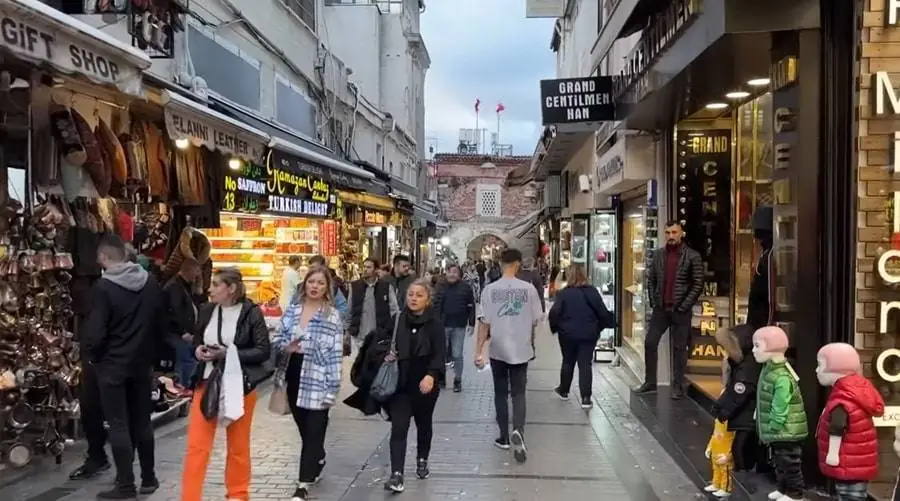Close your eyes for a moment and imagine yourself transported to a bustling marketplace. The rhythmic chatter of a thousand conversations mingles with the melodic calls of shopkeepers hawking their wares. The air itself is a fragrant tapestry, woven with the earthy aroma of freshly brewed Turkish coffee, the sweet perfume of exotic incense, and the pungent tang of spices from faraway lands. This, my friends, is the Grand Bazaar of Istanbul, a place where every sense is delightfully overwhelmed. In this piece of construct I’ll unfold fruitful insights for you on the part of what to buy in Grand Bazaar Istanbul.
Textile Wonders

The Grand Bazaar is a textile aficionado’s dream come true. Within its labyrinthine alleys lies a universe of fabrics, a vibrant testament to Turkey’s rich textile tradition. From the moment you step into a dedicated textile shop, your eyes are met with a dazzling display of colors and textures.
A Tapestry of Fabrics
Traditional Turkish Towels (Peshtemals): These lightweight, fast-drying towels, often adorned with intricate geometric patterns and vibrant colors, are a quintessential Turkish item. They are perfect for the beach, bath, or hammam (Turkish bath) experience.
Silks: Soft and luxurious, Turkish silks come in a vast array of colors and weights. Whether you seek a flowing kaftan, a delicate scarf, or a piece of opulent fabric for a special occasion, the Grand Bazaar offers a treasure trove of options.
Cashmere: For those seeking ultimate comfort and warmth, the Grand Bazaar boasts a selection of cashmere scarves, shawls, and sweaters. The quality is often exceptional, and the prices can be very competitive compared to Western markets.
Handcrafted Textiles: Beyond commercially produced fabrics, keep an eye out for stalls showcasing unique handcrafted textiles. You might find beautiful embroidered pieces, hand-woven tapestries, or stunning examples of traditional techniques like ikat or block printing. These one-of-a-kind finds add a touch of cultural authenticity to your shopping experience.
A Feast for the Tactile Senses
The Grand Bazaar isn’t just a visual spectacle; it’s a feast for the tactile senses as well. Run your fingers across the smooth surface of a silk scarf, feel the weight and warmth of a hand-knitted woolen shawl, or admire the intricate details of an embroidered table runner. The sheer variety of textures adds another dimension to the shopping experience, allowing you to truly appreciate the craftsmanship behind each piece.
Beyond the Fabric
While fabrics dominate the textile section, you might also find other things to buy in Grand Bazaar Istanbul like trimmings, buttons, and haberdashery supplies. This allows you to not only purchase beautiful fabrics but also find everything you need to bring your creative sewing projects to life.
This section provides a detailed and informative overview of the textiles available at the Grand Bazaar. It highlights specific types of fabrics, emphasizes the sensory experience, and mentions additional items that might be of interest to the shopper.
Spice Market
The Grand Bazaar isn’t just a haven for textiles; it also houses a dedicated section known as the Spice Market, a sensory adventure unlike any other. Prepare to be captivated by a vibrant explosion of colors, intoxicating aromas, and an almost overwhelming array of spices, herbs, and teas.
Aromatic Assault
The moment you step into the Spice Market, a wave of enticing aromas washes over you. The air hangs heavy with the earthy musk of cumin, the warm sweetness of cinnamon, the citrusy zest of lemongrass, and the pungent bite of chili flakes. Each stall boasts a colorful display of spices piled high in pyramid-shaped mounds, creating a visual feast that complements the olfactory experience.
A Global Spice Rack
The Spice Market is a treasure trove for culinary enthusiasts. You’ll find an astonishing variety of spices from all corners of the globe, including:
- Saffron: The king of spices, prized for its delicate flavor and vibrant color.
- Turkish Delight: A quintessential Turkish treat, available in a rainbow of flavors and often dusted with powdered spices like cinnamon or rose.
- Exotic Teas: Explore a world of loose-leaf teas, from classic black and green varieties to more unique offerings like hibiscus and apple cinnamon.
- Local Herbs: Discover the unique flavors of Turkish cuisine with a selection of locally grown herbs like mint, oregano, and thyme.
Beyond the Seasoning
The Spice Market isn’t just for foodies. You can also find an array of non-culinary items, including fragrant soaps infused with essential oils, herbal remedies, and potpourri blends to fill your home with exotic scents.
Don’t be afraid to engage all your senses when exploring the Spice Market. Inhale the heady aromas, inspect the vibrant colors of the spices, and even ask shopkeepers to let you sample some of their wares (a common courtesy in the Bazaar). This immersive experience allows you to truly appreciate the diverse flavors and fragrances that the Spice Market has to offer.
This section highlights the sensory experience of the Spice Market, details specific spices and products available, and provides tips for engaging with the vendors to get the most out of your visit.
Turkish Carpets
The Grand Bazaar isn’t just a marketplace for everyday goods; it’s a haven for traditional craftsmanship, and Turkish carpets are a prime example. Stepping into a carpet stall is like entering a world of vibrant colors, intricate designs, and a rich cultural heritage woven into every thread.
A Tapestry of Styles
The Grand Bazaar boasts a dazzling array of Turkish carpets, catering to various tastes and budgets. Here’s a glimpse into the variety you’ll encounter:
- Hand-Woven Masterpieces: The pinnacle of Turkish carpet artistry lies in hand-woven masterpieces. These carpets feature intricate geometric patterns, floral motifs, or even calligraphy, meticulously knotted by skilled artisans. Each piece is a unique work of art, a testament to the weaver’s patience and skill.
- Flat-Woven Kilims: For a more affordable option, explore the world of kilims. These flat-woven rugs showcase bold geometric patterns and vibrant colors, perfect for adding a touch of ethnic flair to any room.
- Regional Specialties: Depending on the stall, you might find carpets specific to different regions of Turkey. Each region has its own distinct style, with variations in color palettes, patterns, and weaving techniques. Look for carpets from Hereke, renowned for their silk and fine knotting, or Kayseri, known for their floral designs and wool-on-wool construction.
Turkish carpets are more than just decorative floor coverings; they’re a window into Turkish history and culture. Traditional patterns often hold symbolic meaning, reflecting nomadic motifs or depicting scenes from nature. Owning a Turkish carpet allows you to bring a piece of this rich heritage into your home.
Carpet Buying Experience
The Grand Bazaar offers a unique carpet buying experience – one of the most conspicuous items when it comes to what to buy in Grand Bazaar in Istanbul. Be prepared for negotiation, a cultural tradition in the Bazaar. Shopkeepers will often quote a starting price, leaving room for bargaining. Research common carpet types and prices beforehand to have a good baseline for negotiation.
Don’t be afraid to ask questions about the carpet’s origin, materials, and weaving technique. Remember, buying a carpet is an investment, so take your time, explore different options, and choose a piece that truly resonates with you.
When to Go to Grand Bazaar

If you crave a relaxed shopping experience with fewer crowds, weekdays are your best bet. Tuesdays and Wednesdays, in particular, tend to be less busy compared to weekends. This translates into more attentive shopkeepers, ample space to browse the merchandise, and a more enjoyable atmosphere for negotiation. However, keep in mind that some shops might have slightly shorter operating hours on weekdays, so it’s always a good idea to check beforehand.
If you crave a relaxed shopping experience with fewer crowds, weekdays are your best bet. Tuesdays and Wednesdays, in particular, tend to be less busy compared to weekends. This translates into more attentive shopkeepers, ample space to browse the merchandise, and a more enjoyable atmosphere for negotiation. However, keep in mind that some shops might have slightly shorter operating hours on weekdays, so it’s always a good idea to check beforehand.
Travelers seeking a unique atmosphere and the potential for better deals, as shopkeepers might be more willing to negotiate towards the end of the day. Elevate your experience of Istanbul Grand Bazaar with our top-rated tour offering.
Thursday evenings, as some shops stay open a bit later, typically around 7:30 PM. This allows you to experience the Bazaar’s nighttime charm without the daytime hustle and bustle.
How to Avoid Rush
This is the time to truly experience the Grand Bazaar like a local. While the weather might be colder, you’ll encounter the fewest crowds and potentially the best bargains, as shopkeepers might be more flexible with prices. However, be aware that some shops might have reduced hours during this time.

